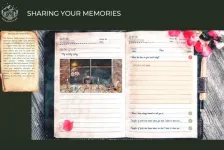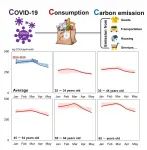(Press-News.org) Due to their complexity and microscopic scale, plant-microbe interactions can be quite elusive. Each researcher focuses on a piece of the interaction, and it is hard to find all the pieces let alone assemble them into a comprehensive map to find the hidden treasures within the plant microbiome. This is the purpose of review, to take all the pieces from all the different sources and put them together into something comprehensive that can guide researchers to hidden clues and new associations that unlock the secrets of a system. Like any good treasure map, there are still gaps in the knowledge and the searcher must be clever enough to fill in those gaps to find the "X". Without a map, there is only aimless wandering, but with a map, there is hope of finding the hidden treasures of the plant microbiome.
Yunzheng Zhang, Nian Wang, and colleagues recently put together a map, "The Citrus Microbiome: From Structure and Function to Microbiome Engineering and Beyond," which they published in the Phytobiomes Journal. Their map outlines the structure and potential functions of the plant microbiome and how this knowledge can guide us to new engineering feats and a greater understanding of the hidden treasures of the plant microbiome. Once revealed, insights into the microbiome may help researchers grow more resilient citrus plants that are both more suitable for changing climates and more capable of surviving pathogen pressures.
Citrus is a globally important perennial fruit crop that has many economic and emotional ties to society. It is cultivated in more than 140 countries, exposing it to a variety of environmental and disease pressures. Our relationships with citrus are diverse, but not as diverse as the relationship between the citrus and its microbiome. As we shift to an ever-destabilizing environment, it becomes more imperative to understand these interactions to ensure citrus will be present in our lives in the years to come.
Nian Wang believes, "harnessing citrus-microbiome interactions to address biotic and abiotic stressors offers an opportunity to increase sustainable citrus production." To create this treasure map of citrus-microbe interactions, Wang and colleagues established The International Citrus Microbiome Consortium in 2015. Their goal was to form international collaborations to address this global problem. Before understanding the ins and outs of this ecosystem, the team had to know which individual microbes build the citrus microbiome community and how the microbial community may function throughout the different niches of the plant.
After identifying microbes and some of the overall functions the microbiome is performing collectively, the question turns to how they are doing it. Once researchers understand the who, what, and how of the microbiome they can then start to engineer new microbes or design synthetic communities to perform a specific function that may address current deficiencies like crop production, disease spread, and other citrus health ailments. In their review, Zhang, Wang, and colleagues specifically address the first question by combining multiple metagenomic studies into one cohesive paper and confidently stating which microbes make up the citrus microbiome in the rhizosphere (around the root), rhizoplane (on the root), endorhiza (inside the root), and phyllosphere (leaf surface).
This review highlights the exhaustive research that has been done on the citrus microbiome thus far and cleverly assembles this knowledge into one comprehensive figure. The citrus rhizospheres were enriched with microbes belonging to the pyla of Proteobacteria and Bacteroidetes, which is common in other plant rhizospheres. Bradyrhizobium and Burkholderia microbes were the most dominant groups in the transition from rhizosphere to rhizoplane. The endorhiza microbiome biomass is approximately a fifth of the rhizosphere biomass and is dominated by Proteobacteria, Firmicutes, and Actinobacteria, as is the phyllosphere.
But authors note that there is still so much to learn and discover. At this point, researchers only know which microbes are present in some of the tissue, meaning there is still a significant amount of research to be done to unlock the hidden treasures within the citrus microbiome. With this knowledge, it's time to start incorporating multiomic technologies, such as transcriptomics (the study of RNA) and metabolomics (the study of metabolites), in addition to the DNA-sequencing techniques that have previously been used. It is an exciting time to be a plant or agricultural scientist because they are on the cusp of integrating novel technologies to understand a world we can't even see: the world of the microbiome.
"I think artificial intelligence will be critical for us to mine a humongous amount of data. Regarding how to utilize the microbiome, I think synthetic community or consortia of microbes, as well as CRISPR-mediated genome editing, will provide the most promising path for the application," said Wang. An integrated problem of this size, involving so many moving parts, does not only need an international consortium of top researchers but also a highly interdisciplinary team that includes not only plant scientists, microbiologists, and plant pathologists but also experts in the fields of bioinformatics, horticulture, and computer science. Only banded together can this crew of scientists put together the missing pieces of the map and unlock the treasures within the citrus microbiome before it's too late.
INFORMATION:
This research article was made possible by the collaboration of Yunzeng Zhang, Pankaj Trivedi, Jin Xu, Caroline Roper, and Nian Wang. Yunzeng Zhang recently started a professorship at Yangzhou University in China. Pankaj Trivedi is now an assistant professor at Colorado State University and Jin Xu is currently a PhD under the mentorship of Dr. Nian Wang. You can find the full article in the Phytobiomes Journal. You can stay up to date with Nian Wang's Lab's research on Twitter at @NWangUF.
Author Bio: Tess Deyett, Ph.D. is a current postdoc under the guidance of Dr. Philippe Rolshausen at the University of California Riverside. She serves as an assistant feature editor for the Phytobiomes Journal. A passionate and driven science communicator, Tess also hosts her own website microbigals.com and podcast The Microbe Moment. She aspires to share how microbes are a constant force of good to every person and that everyone has many unique microbe moments!
When a loved one dies, memories of that person become particularly valuable in connecting the mourners with the deceased. A new Weill Cornell Medicine online application, called Living Memory Home, offers a virtual and personal memorial space that allows mourners to deposit their memories and feelings about their loss and honor their loved one.
Living Memory Home users are able to create a memorial space that they can personalize with photos and messages. They can customize a virtual cabin and choose an appropriate view. The curated set of questions prompt users to write memories ...
AMES, Iowa - New variants of the SARS-CoV-2 virus most likely will necessitate the development of more vaccine options in the years ahead, and a biomedical scientist at Iowa State University believes the "key" to that development lies in the way the virus binds to human cells.
Michael Cho, a professor of biomedical sciences at Iowa State, is studying how to develop COVID-19 vaccines that target SARS-CoV-2's receptor-binding domain, or the part of the virus that docks with the host cellular receptor, angiotensin converting enzyme 2 (ACE2). This docking process allows the virus access to the host's cells, which leads to infection.
Cho was the lead author of a study recently published in the peer-reviewed scientific journal Frontiers in Immunology detailing the ability of a vaccine ...
Unlike the oscillations of sound waves, the oscillations of light are so fast that extremely complex equipment is needed to observe them directly. However, it is possible to measure the frequencies of these oscillations indirectly with frequency combs. These combs are made up of a set of regularly spaced "teeth" where each tooth corresponds to a frequency. Used as a graduated ruler, they offer the possibility of measuring an optical frequency with great precision. This makes it possible, among other things, to measure variations in the distance between the Earth and the Moon with an accuracy ...
MADISON - By engineering a short chunk of protein, or peptide, that can prevent the attachment of human parainfluenza viruses to cells, researchers have improved a method in rodent models intended to help keep children healthy.
Human parainfluenza viruses, or HPIVs, are the leading cause of childhood respiratory infections, responsible for 30% to 40% of illnesses like croup and pneumonia. The viruses also affect the elderly and people with compromised immune systems.
To sicken people, HPIVs must latch onto cells and inject their genetic material to start making new viruses. HPIV3 is the most prevalent among these viruses. ...
Autistic people have far greater risks of long term physical health conditions than others, but the reasons for this remain unclear. New research from the University of Cambridge suggests that unhealthy lifestyle habits may be an important contributing factor. The results are published today in the journal Molecular Autism.
Earlier research suggests that autistic people die 16-35 years younger than expected, and that greater health problems may contribute to this risk. The present study is the first to consider the diet, exercise, and sleep patterns of autistic adults and how these patterns may relate to health outcomes.
The team at the Autism Research Centre in Cambridge developed an anonymous, online survey about lifestyle choices and daily habits, personal medical history, ...
The Covid-19 pandemic, like many other health crises, has had unequal effects on the U.S. population, with communities of color often hit the hardest. A new study co-authored by an MIT professor identifies a related challenge: Different social groups have different reactions to the fact that Covid-19 has generated those health inequities.
More specifically, the study, based on a multilayered survey of U.S. residents, finds a divergence among racial groups when people are informed about the varying effects of the pandemic. Upon learning more about the social distribution of Covid-19, Black Americans tend to gain a better understanding of their risk. But among white Americans given the same information, ...
Australian photovoltaics researchers have made a 'cool' discovery: Singlet fission and tandem solar cells - two innovative ways to generate solar power more efficiently - also help to lower operating temperatures and keep devices running for longer.
Tandem cells can be made from a combination of silicon - the most commonly used photovoltaics material - and new compounds like perovskite nanocrystals, which can have a larger bandgap than silicon and help the device to capture more of the solar spectrum for energy generation.
Singlet fission, meanwhile, is a technique that produces twice the electronic charge carriers than normal for each photon of light that's absorbed. ...
A chemical that the NSW government has recently partially banned in firefighting has been found in the pups of endangered Australian sea lions and in Australian fur seals.
The finding represents another possible blow to Australian sea lions' survival. Hookworm and tuberculosis already threaten their small and diminishing population, which has fallen by more than 60 percent over four decades.
The new research - part of a long-term health study of seals and sea lions in Australia - identified the chemicals in animals at multiple colonies in Victoria and South Australia from 2017 to 2020.
As well as in pups, the chemicals (Per- and polyfluoroalkyl substances - 'PFAS') were detected in juvenile ...
Despite the rapid and significant changes in consumption patterns witnessed during the initial months of the COVID-19 pandemic, Japanese households maintained their normal levels of greenhouse gases emissions. The "anthropause" -- reduction of human activity due to the pandemic -- made headlines last summer, but factory shutdowns and broken global supply chains did not translate into the adoption of eco-friendly lifestyles for the average household.
"During the early COVID-19 period, we could witness lifestyle changes happening around us fast, so we decided to explore the environmental impacts of these lifestyle changes. Some other research at that period was showing that the production-side greenhouse gases emissions ...
The promise of a quantum internet depends on the complexities of harnessing light to transmit quantum information over fiber optic networks. A potential step forward was reported today by researchers in Sweden who developed integrated chips that can generate light particles on demand and without the need for extreme refrigeration.
Quantum computing today relies on states of matter, that is, electrons which carry qubits of information to perform multiple calculations simultaneously, in a fraction of the time it takes with classical computing.
The co-author of the research, Val Zwiller, Professor ...






